In the kitchen garden this morning it was clear that we had a prominent color theme emerging in the harvest baskets. Purple…a plethora of purple!
Until now, we hadn’t really paid all that much attention to how many different purple varieties of vegetables we’d planted in the garden this year.
The purple and blue colors seen in fruits and vegetables are primarily due to flavonoid pigments called Anthocyanins.
Anthocyanins are believed to serve a number of functions in the host plant, including pollinator attraction [1], which may confer a competitive pollination edge relative to surrounding plants.
These pigments may also enhance predator attraction, facilitating the consumption, and redistribution, of seed. Perhaps that explains why the rodents were gnawing on the fruits of our eggplants earlier this season.
Anthocyanins are also thought to be potentially phytoprotective in the leaves and fruits of plants, functioning as a sort of sunscreen, by absorbing harmful wavelengths of light.
Perhaps most importantly, Anthocyanins are powerful antioxidants, and have been suggested to have cardioprotective, hepatoprotective, anti-inflammatory, and anti-neoplastic properties. [2,3,4] Although there is still some debate in the literature as to how bioactive some of these flavonoid compounds are when consumed in the diet, they are one of the reasons we’re encouraged to eat a wide variety of fruits and vegetables, and make our daily meals as colorful as possible.
Among the plethora of purple produce we harvested this morning, were four varieties of eggplant (Solanum melongena). The heirloom eggplant ‘Rosa Bianca’ is proving to be a robust variety, producing a number of modest sized 8-10 oz fruits.
‘Little Fingers’ though is our favorite variety this year. Sweet, and tender, these little eggplants have been producing all summer, and show no signs of slowing down.
Rivaling ‘Rosa Bianca’ for the title of prettiest eggplant, is the heirloom ‘Listada de Gandia’.
Although not as prolific as ‘Little Fingers’, these plants are producing very generously. The fruits are as sweet and tender, and they’re simply stunning, both in the garden, and on the plate.
The last eggplant variety harvested this morning was ‘Long Purple’.
This particular variety seems to have an overabundance of Anthocyanin pigments, especially in the leaves, stems and flowers of the plant.
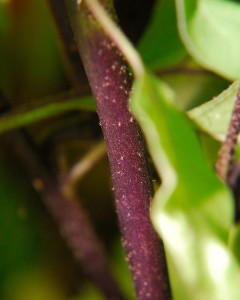
The stems of ‘Long Purple’ are also intensely purple colored. All of the other eggplant varieties have green stems
The eggplants don’t have Anthocyanin exclusivity in the garden though. These purple colored bush beans (Phaseolus vulgaris) are the heirloom ‘Royal Burgundy‘.
The plants have been lush, and a favorite with the voles, but despite the damage we are managing to harvest a few.
Like the ‘Long Purple’ eggplant, these vines have purple stems, leaf veins, and flowers.
As beautiful as these beans are on the vine though, the pigment in the beans isn’t heat stable, and the color quickly dissipates as soon as the beans are blanched or cooked, turning the beans green.
This is less of a concern for the ‘Purple Beauty’ sweet peppers (Capsicum annuum) though.
Bell peppers can easily be eaten raw, preserving their unique color in summer salads.
Perhaps my most favorite Purple vegetable though, is this, the ‘Purple Majesty’ potato.
The skins are a deep, rich purple, but unlike the peppers, beans, and eggplants, these potatoes are purple on the inside too.

Purple potatoes, like ‘Purple Majesty’ are very rich in Anthocyanins, and hold their color quite well when cooked
Not only is this variety prolific, the purple color is retained better when cooking. For some reason I now have a serious craving for some blue homemade potato chips!
As the potatoes will keep for a while though, I suspect that this long-weekend we’ll be making a LOT of grilled eggplant instead!
Are you growing any purple produce in your vegetable gardens this summer?
——————–
[1] Harborne J, Smith D., Correlations between anthocyanin chemistry and pollination ecology in the polemoniaceae. Biochemical Systematics and Ecology. 1978 Jun; 6(2):127-130.
[2] Das S, Raychaudhuri U, Falchi M, Bertelli A, Braga PC, Das DK. Cardioprotective properties of raw and cooked eggplant (Solanum melongena L). Food Funct. 2011 Jul;2(7):395-9. Epub 2011 Jun 10.
[3] Nisha P, Abdul Nazar P, Jayamurthy P. A comparative study on antioxidant activities of different varieties of Solanum melongena. Food Chem Toxicol. 2009 Oct;47(10):2640-4. Epub 2009 Jul 26.
[4] Akanitapichat P, Phraibung K, Nuchklang K, Prompitakkul S. Antioxidant and hepatoprotective activities of five eggplant varieties. Food Chem Toxicol. 2010 Oct;48(10):3017-21. Epub 2010 Aug 5.

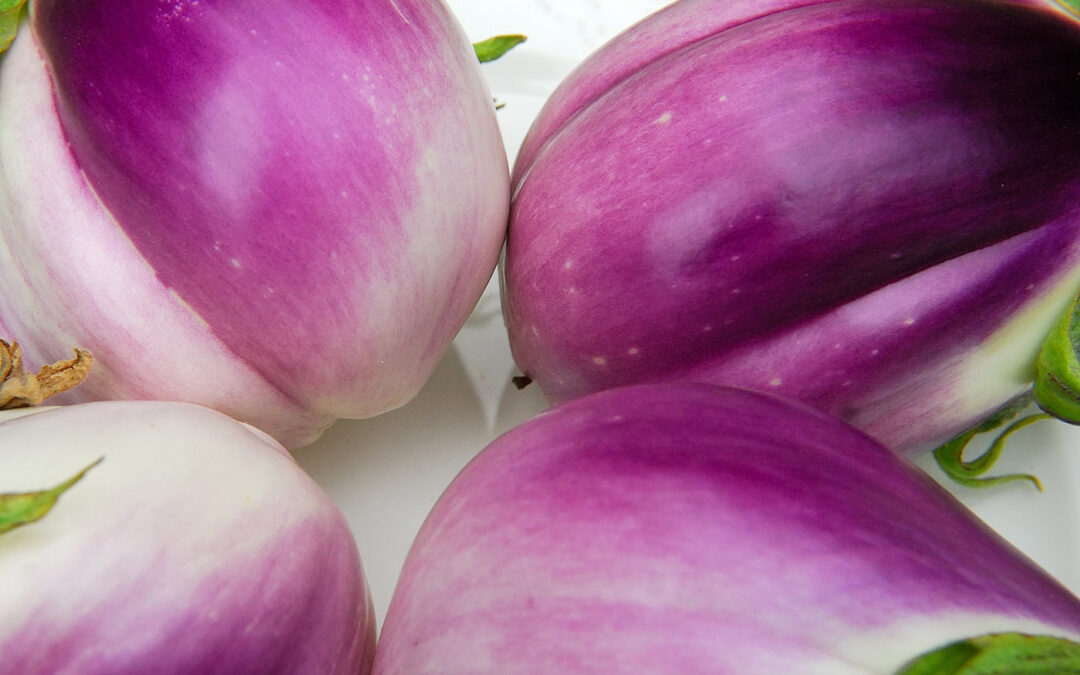
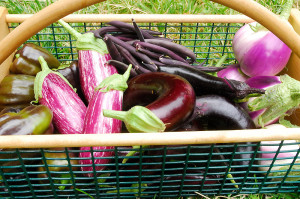
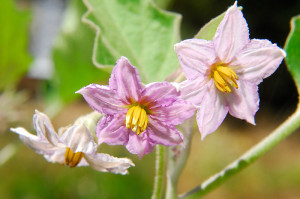
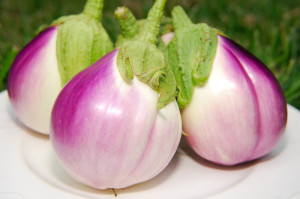

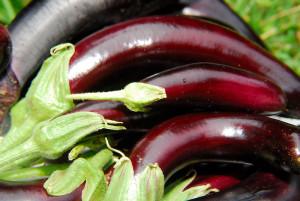
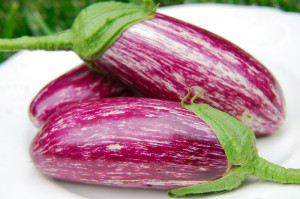
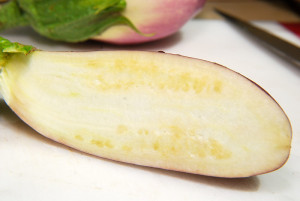

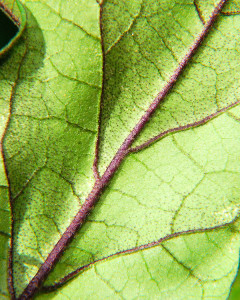

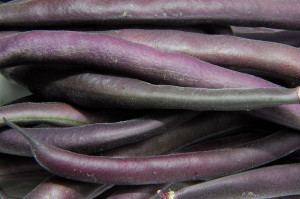
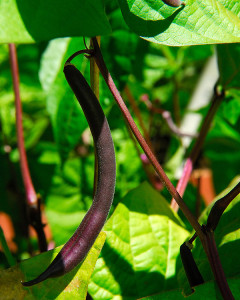
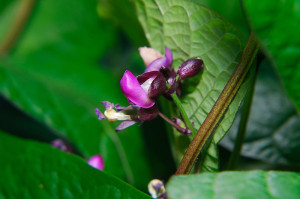
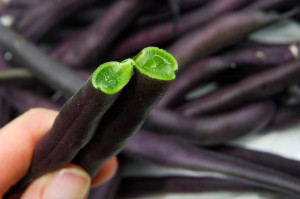
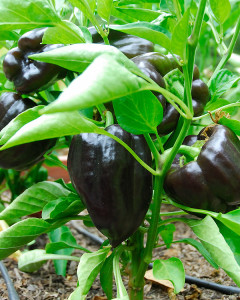

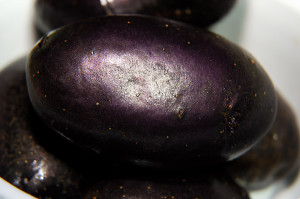
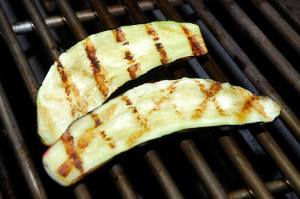








Beautiful, and thanks for the info on anthocyanins. Only ‘Rosa Bianca’ is purple here, unless you count hyacinth bean pods, which I’m still not certain aren’t poisonous — I’m not eating them!
I don’t blame you, beside, I think hyacinth bean pods are pretty enough to simply be admired for their aesthetic qualities in the garden 😉
Look at all that luscious purple! It is so pretty it is almost to good to eat. I didn’t have success growing eggplant this summer. Looking at all the varieties you grew makes me want to try again.
I’m we’ve had some recent summers that if we’d tried to grow eggplant, it would have proven to be a dismal failure. They want warm rich soils, lots of sun, and plenty of moisture. Even then they may not be happy. I’m this season isn’t a fluke for us, but we’ll see how they do next year too!
Wow!! I did not realise how many purple veggies there are – I am growing red cabbage (purple if you ask me!) I must try eggplant. Those Purple Bell Peppers – WOW! Never have seen this before! I can’t wait for my veggie patch to grow.
I agree, red cabbage is definitely more purple than red. I tried to grow some last year, but our winter was a little too dry and warm, and the plants bolted. I might try again this winter though, along with some red kale, just to keep a splash of color in the garden!
You always have something interesting in your kitching garden Clare and am rather green with envy over your purple produce. Beautiful enough to don kitchin walls as I’m not usually keen on egg plants. Your images are so tempting though so wondering how long you grill them for?
Grilling time depends somewhat on variety, as many of the heirlooms are significantly different in size. However, that said, most of the Japanese-type small eggplants, split in half lengthwise, can be grilled for about 3-5 minutes per side. Just enough to get some color, but no so much that they get mushy. I usually squeeze the sides with a pair of barbecue tongs. I want some give, but still want to feel a little resistance. For the larger varieties, like the Rosa Biancas, I’ll usually score the flesh two or three times with a sharp knife, down almost to the skin. This encourages extra moisture to drain out, and helps them cook a little more evenly.
Clare I see we both love purple veggies…I grew a purple/blue potato variety and I also grew the purple bush beans…love them the best….then there are the eggplants…I love all the different varieties and hope to grow more next year as I will need to start them earlier next year so the harvest is better. Wonderful harvest of my favorite color.
I would definitely be starting eggplants as early as you’d start tomatoes. Here that means I’d sow them (in flats, indoors) around early-mid February. They want a long season of warm soil, but they can also be a bit persnickety to germinate too. If you sow your own from seed, don’t let the soil dry out, and if you can start them indoors on a heat mat, germination improves significantly.
A purple overdose – so many different shades! The potato is amazing. I hadn’t realised the implications of purple and blue in vegetables. A pity the colour so often fades on cooking.
Aren’t those potatoes fabulous? I probably would have been afraid to eat a purple potato as a child, but I really love these. We grew another variety called ‘All Blue’ a few years ago, which also grew quite well. ‘Purple Majesty’ does have higher yields for us though, and I think their texture holds up better when cooked too. They also look great in a summer holiday red-white-and-blue potato salad too! 😉
The colors are so beautiful. Some of my beans and peppers boast these colors, but I usually have some yellow squash and red tomatoes in my morning harvest basket. Everything you have photos of here looks delectable. I almost wish I liked eggplant because they do look tasty. I do, however, like their flowers…gorgeous.
We didn’t grow any yellow squash this year. The variety we grew last year was seedier than we’d like, and I didn’t bother to order a different type this spring. I will definitely grow something next year though, as I prefer the yellow squash for the zucchini pickles we make. Tomatoes here we have, lots and lots of them, but those are harvested separately. I’m not a huge fan of eggplant if I’m honest, and very fussy about how it’s prepared. My first few experiences with eggplant weren’t good ones, so it’s taken me a while to come around to appreciating them in the garden. This year though, I think they’ve finally won me over 🙂
I have never been a fan of eggplant, but my exposure has been limited. Certainly I have never eaten it grilled. Yours looks delicious! Purple potatoes is another matter. These I love and I seriously want to grow some. Purple potato chips sound fantastic!
If, like me, you object to the mushy texture of some eggplant, rather than the flavor, you might prefer some of these heirloom varieties. I really like the heirloom ‘Little Fingers’. It’s not only prolific, but harvested when they’re small (less than 6 inches in length), sliced crosswise, and lightly sauteed, or added to a stir fry, they really do hold their texture very well. This year I think my favorite ones for the grill are Listada de Gandia, and Long Purple. They’re small enough, that grilled, the inside is done before the outside turns to mush. For dishes like Baba Ghanouj though, where you’re going to puree the eggplant anyway, I think Rosa Bianca is my favorite. Speaking of Baba Ghanouj…I really need to post our recipe, as it’s one of my favorite ways to eat eggplant! 🙂
I used to grow a fair number of purple vegetables – beans, snap peas, kohlrabi, kale, tomatillos, carrots, broccoli, peppers, but this year it’s just eggplant. Do you know that there is now a purple tomato? Oh wait, I just remembered that I have a bunch of seedlings of Purple Peacock broccoli almost ready to plant out.
You are fairly close and seemingly in a similar climate, although I suspect you get a bit more warmth in the “summer” than I do. It would be fun to meet up some time and swap seeds and/or seedlings. Now I need to go mosey around your blog and see what you’ve been up to!
I have seen the OSU-developed ‘Indigo Rose’ tomato. I’m tempted to try it next year. Even though it’s not an heirloom, it is an open-pollinated, non-GMO, variety. I think it’s worth growing for the color alone, although, I do wonder how the flavor is.